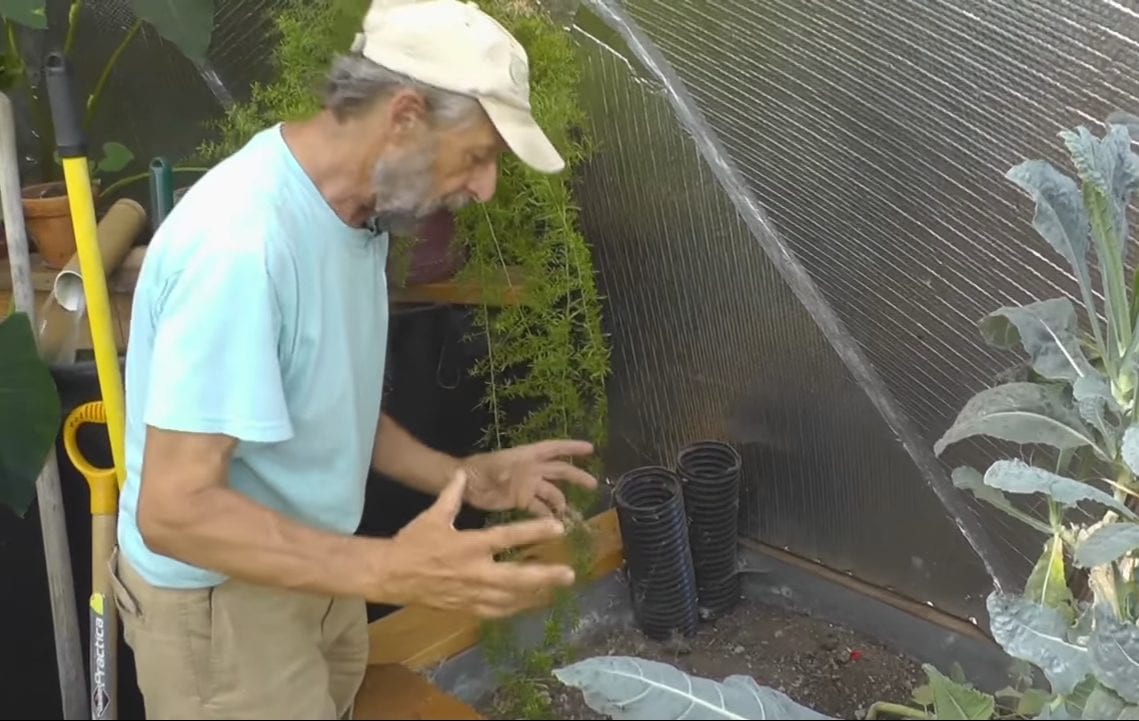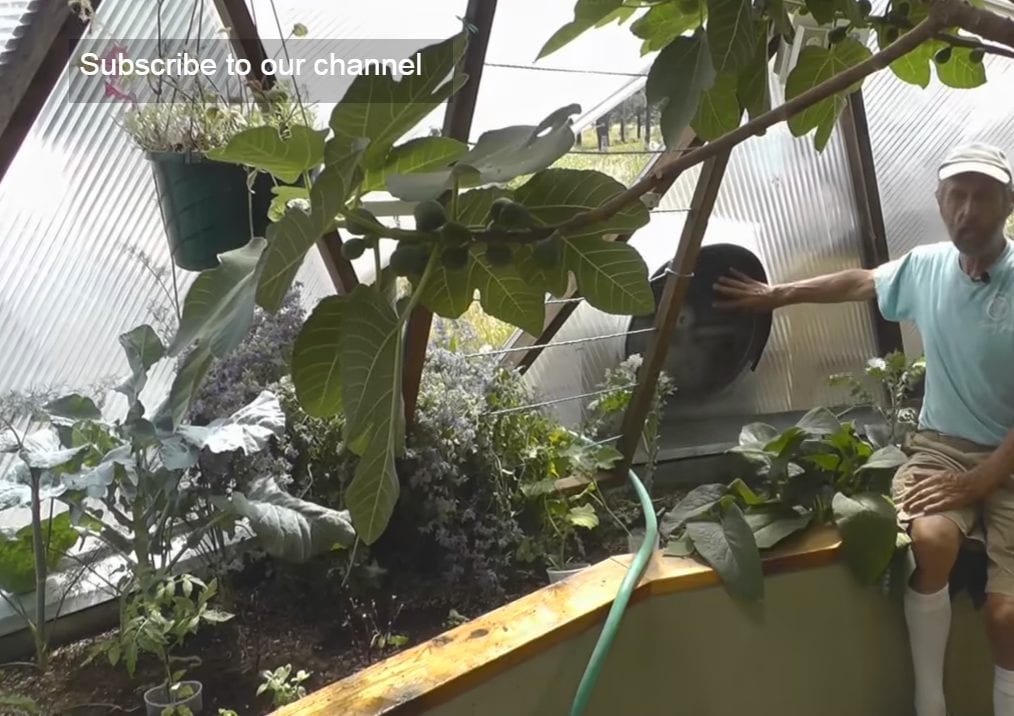7 Ways to Keep Your Growing Dome Greenhouse Cool
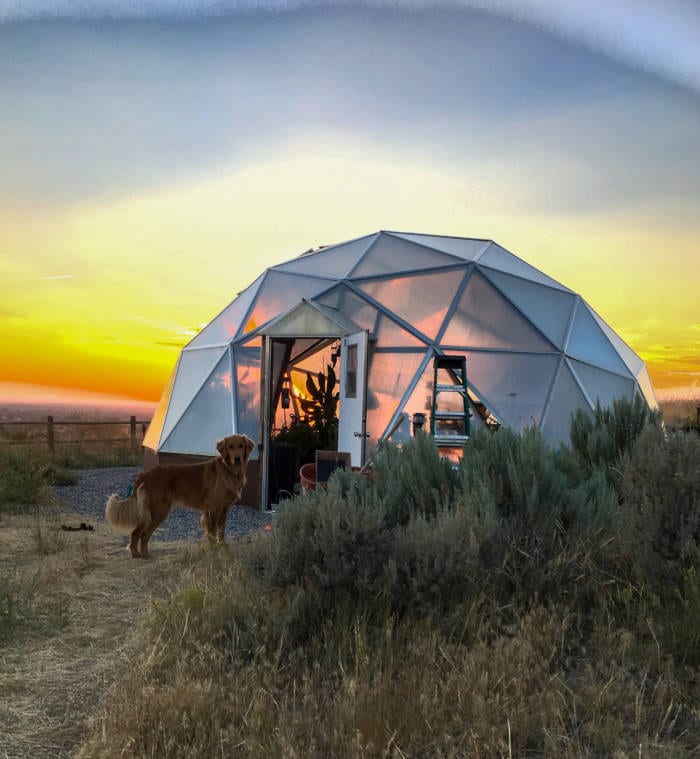
You can keep your greenhouse cool…even in the heat of summer.
A greenhouse is designed to attract and trap heat. They are bound to get hot, but you don’t want them to get too hot. The Growing Dome Greenhouse is designed to maintain the same temperature or less, than the outside air in summer.
Udgar is here to show you 7 Methods How to Keep a Greenhouse Cool.
First – utilize Large Leaved Plants in strategic places…
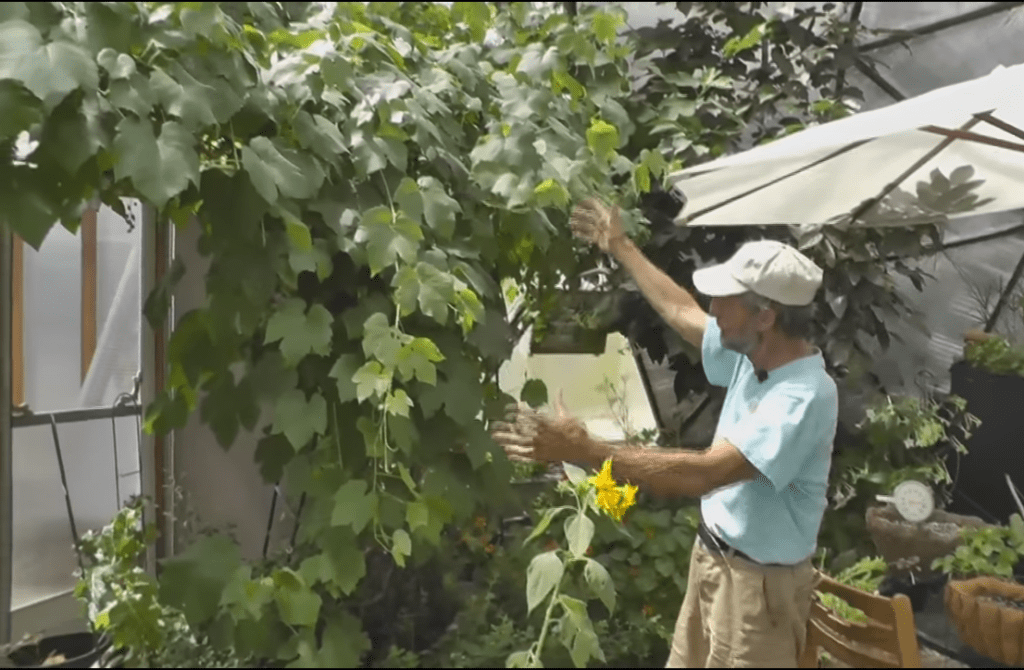
Plants are nature’s evaporative cooler. The single most important way to keep your greenhouse cool is to have a large volume of plants in your greenhouse, especially large-leaved plants such as these fig trees, or this grapevine. They are both edible, fruit-bearing, soil shading, evaporative coolers.
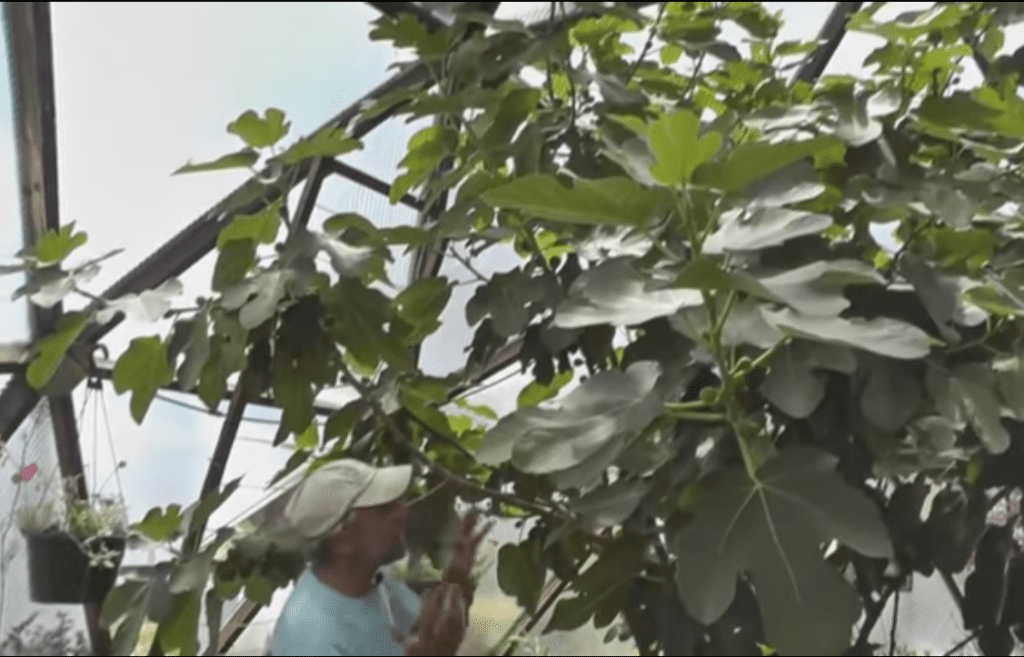
The large leaves help shade the soil and keep the soil cool. In this particular 33′ Growing Dome, we have about 40 tons of soil.
If that 40 tons of soil reaches 110° or 120° because it’s bare dirt, this dome would be a lot lot hotter than if we have 40 tons of soil at 75° or 80°.
Plants transpire moisture through their leaves, which helps keep your greenhouse cool. Transpiration is the process of water movement through a plant and its evaporation from leaves, stems, and flowers. Water is necessary for plants, but only a small amount of water taken up by the roots is used for growth and metabolism. The remaining 97–99.5% is lost by transpiration and guttation.
Have you ever been hiking or riding your mountain bike through an open field or clearing on a hot day, and then quickly enter a dense forest? The temperature immediately drops 20 degrees, and you feel a refreshing blast of humidity in your face? That is transpiration.
Second – The Water Tank
We talk a lot about how the water tank helps keep the dome warm in the winter. It also helps keep the dome cool in the summer. The water tank contains between 600 and 3,000 gallons of water, depending on the size of the dome, which is cooler than the ambient temperature. If it were 80 degrees in your greenhouse and you stuck a hand into the pond, it would feel significantly cooler than the air around you.
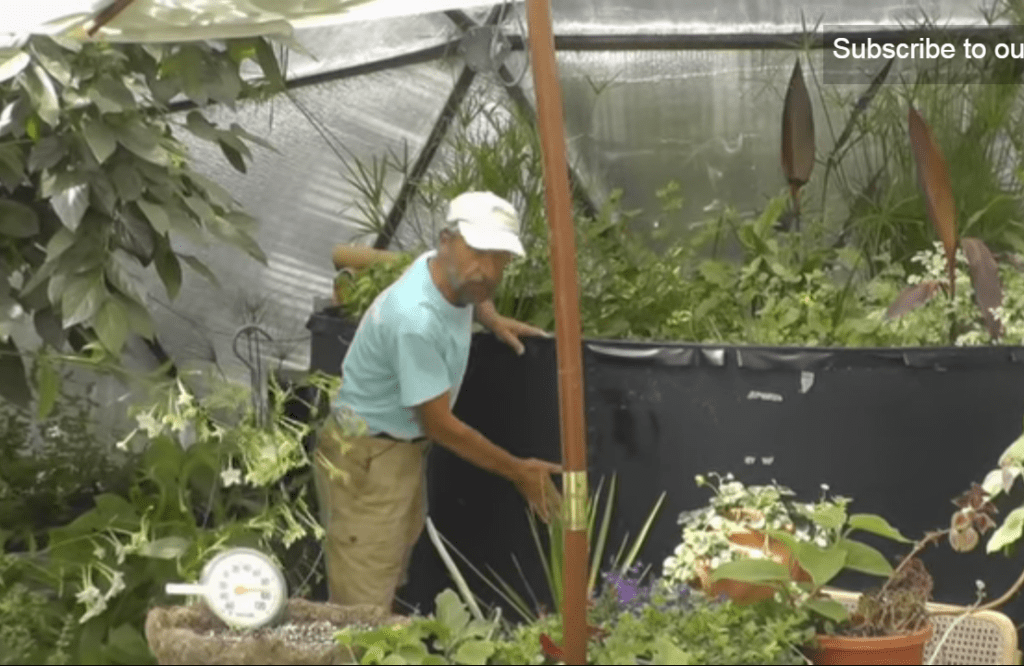
Temperature exchange happens easily through the sheet metal framing of the tank. The temperature outside could be 90°, trying to climb to over 100°, but the thermal mass of the 75° water keeps the dome cool. Evaporation will also occur from the top of the tank, helping to add humidity and cooling your dome. The Solar Powered Water Feature upgrade also helps to add more moisture to the air, especially when using the new spray option.
Hint: install an oscillating fan near the pond or a small fan to the lumber brace behind the spitter to further increase evaporative cooling from the water tank.
Third – Air Flow, Solar and Electric Fans
Proper air circulation and ventilation in a greenhouse is so essential. The ventilation system of a greenhouse not only provides fresh air to the plants (CO2), it also helps to control temperature and humidity. Greenhouses are generally enclosed structures that will not ventilate entirely on their own. To ensure easy, reliable ventilation, Growing Spaces has designed automated vents and fans.
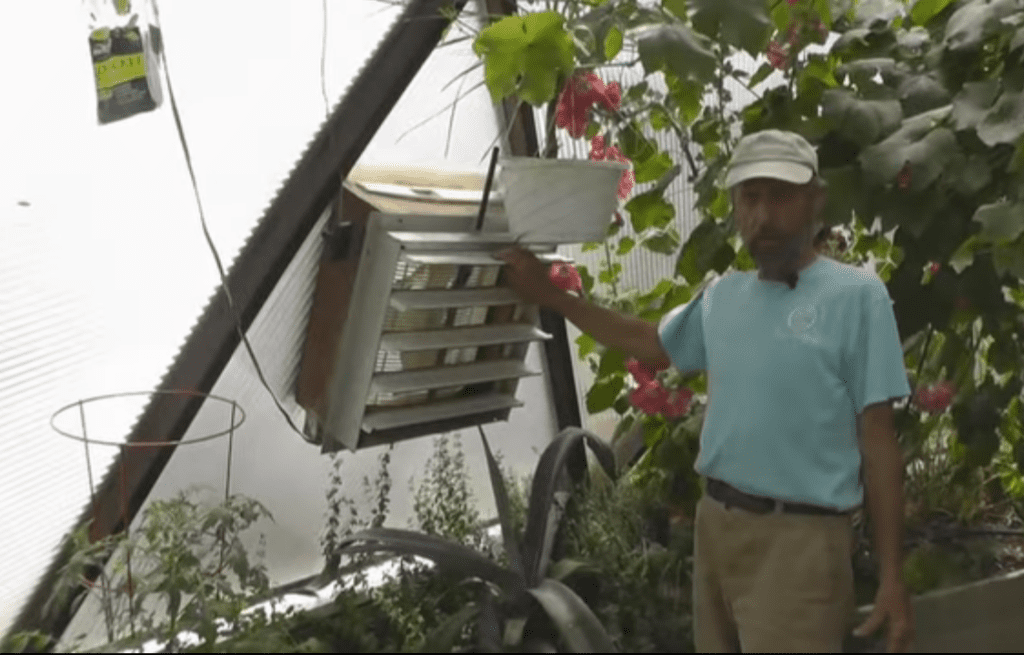
Here is an example of a 110 volt fan in our 33′ Growing Dome which helps move air. We also use direct drive cooling fans run from solar panels.
Upgrade to an extra solar-powered exhaust fan with any Growing Dome® greenhouse kit. The kit includes the 12″ endless breeze fan (12 volt DC), thermostat, shutter, uni-vent piston, solar panel, exterior hood, and hardware.
The 33′ and 42′ Growing Domes now come with solar attic fans standard, one in the 33 and two in the 42. This is also available as an upgrade in the 26′. The larger domes require more active circulation to keep the Growing Dome cool. We can also easily retrofit existing domes with this upgrade.
Fourth – Automatic Vent Openers
Here is a shot of the upper vents…
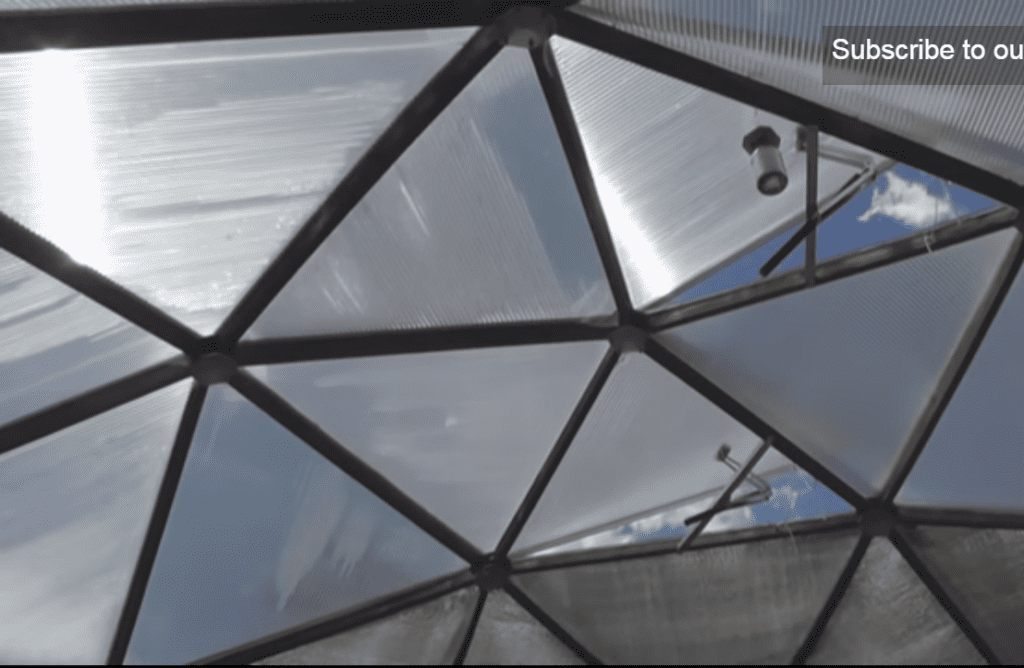
…here are the lower vents.
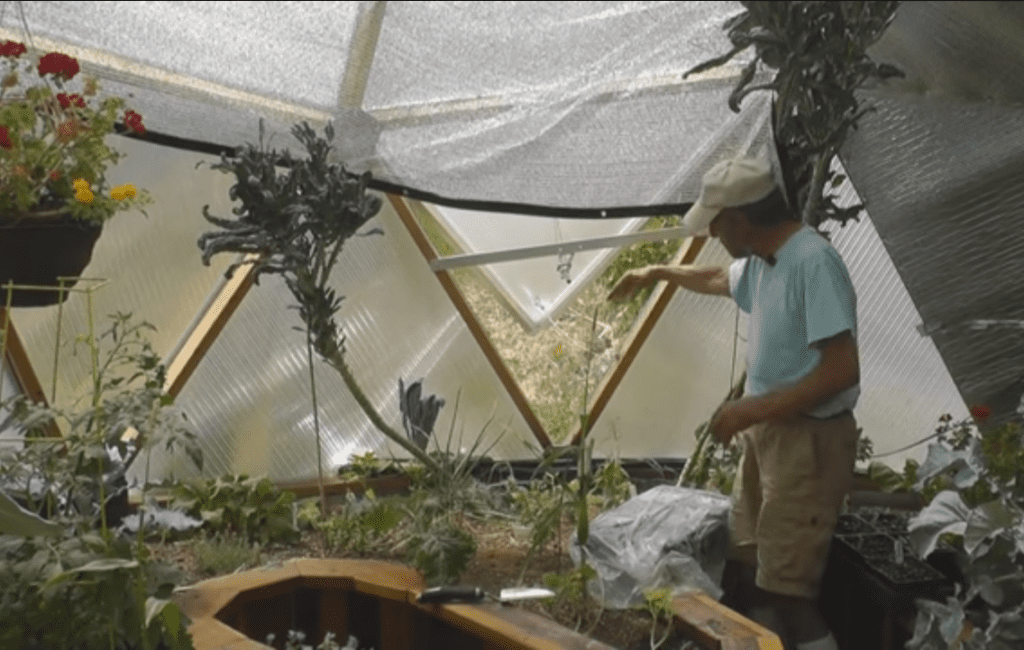
Our automatic solar greenhouse vents are heat activated and require no electricity to operate. The upper and lower automatic greenhouse vents open and close at an adjustable preset temperature due to the expansion and contraction of a beeswax solution within a cylinder and piston. Greenhouse venting and cooling of the Growing Dome® is then achieved as warm air escapes from the top vents, and cold air is drawn in through the lower vents. Heating of the Growing Dome® creates a “chimney” effect. During colder months, the solar greenhouse vent openers are easily disconnected to close the vents at will.

The Growing Dome naturally creates a convection system when the hot air escapes from the top and gets replaced by cooler air from the bottom vents.
Fifth – Creating Shade
There are two main ways to create shade in your Growing Dome. The first is through nature itself—select plants with large leaves. The large leaves help shade the soil, thus keeping your greenhouse cooler. (The more extensive the leaves, the more transpiration!) Deciduous trees outside the dome, ideally on the South-West side are also a great way to shade your dome in the summer.
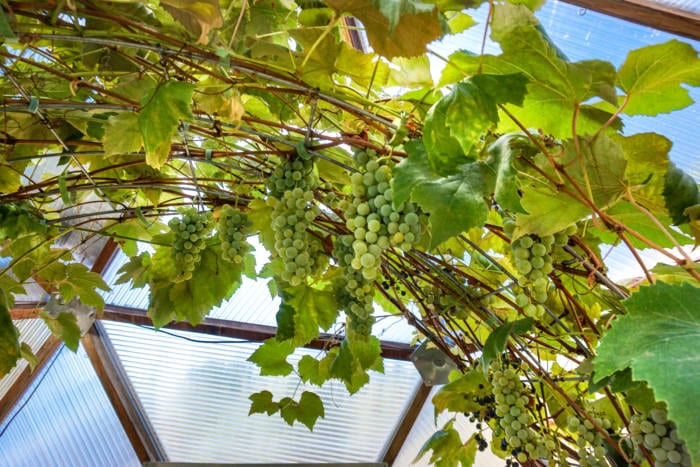
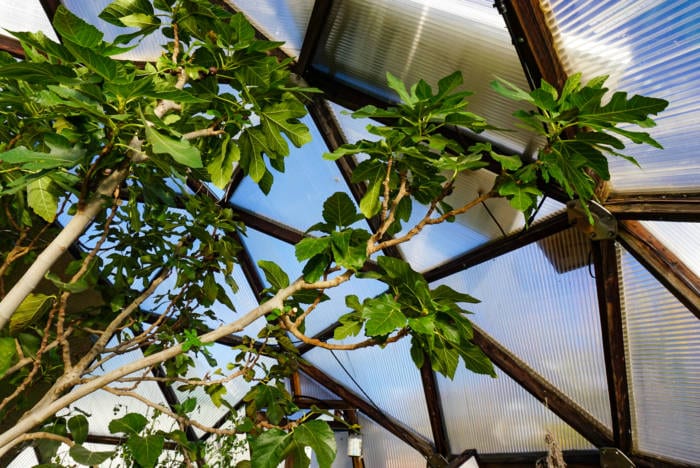
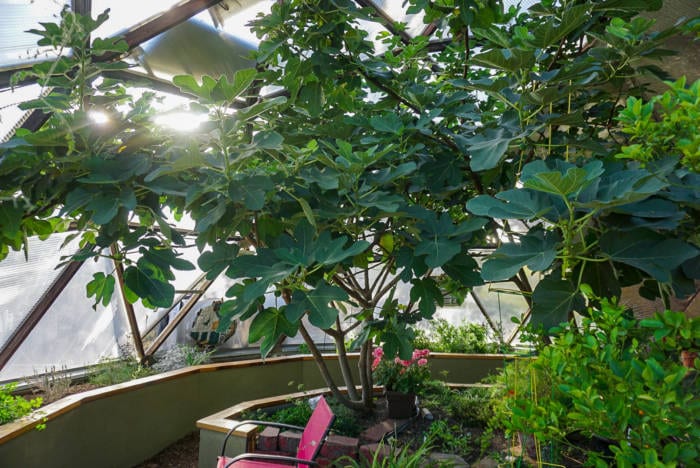
The second way to create shade is with one of our custom-designed aluminet shade cloths. The shade cloth reduces the amount of summer sunlight by 50% without depriving the plants of too much light. They come standard with the kit and are custom made to fit each of the different Growing Dome sizes. The kit also comes with strings and eye bolts for easily attaching it to the struts inside the greenhouse. Most Growing Dome owners put it up between April – June and take it down between September – October.
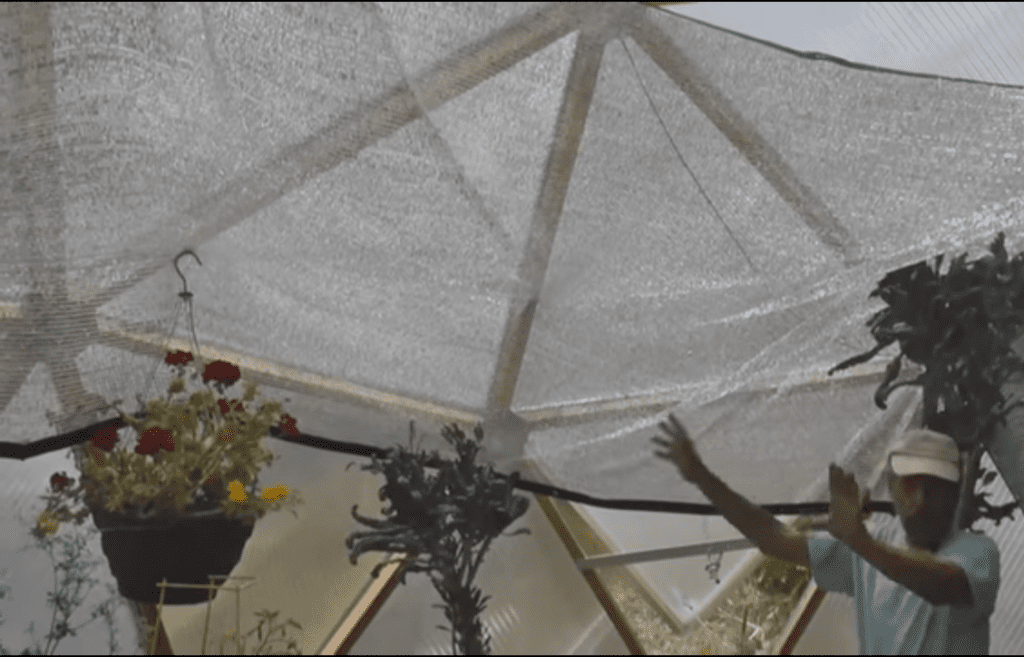
However, if it is a dark colored shade cloth, it will get hot, and you can actually increase the temperature.

This particular shade cloth is called Aluminet®. It’s made of aluminum and it doesn’t heat the inside of the Growing Dome.
We recommend a 50 percent shading.
Do not cover the whole of the dome. You don’t want to have too much shade and make the plants leggy.
With the shade cloth hung on the south side, you cut down the midday sun, but still get early morning and late afternoon sun.
Sixth – Undersoil Fan/Climate Control System
To utilize the natural geothermal capacity of the soil beneath the greenhouse, perforated 4″ pipes are placed in the perimeter raised beds then buried when filling with soil. We call this the Undersoil Ventilation System, previously known as the central air system, or undersoil heating & cooling system. The end of the pipes protrudes 3 – 6″ above the foundation wall, so the soil does not fall in. The ends by the above-ground pond intake air and the ends on the south side of the greenhouse exhaust air. Mounted in a box covering the exhaust pipes, the 12 volt, 4″ fan pulls air, though. A PV solar panel mounted on the Growing Dome greenhouse powers the fan. At 70 cubic feet per minute (CFM), the fan pulls the hot or cool air near the pond through the pipes and soil. This helps warm the soil in the winter and cool it in the summer. Additionally, the fan moves and circulates air in the greenhouse.
Since we have shaded soil at 75°, and 95° air blowing through the soil….
….the air comes out at 85°.
So we’re actually cooling the dome by blowing hot air through pipes buried in the soil.
Seventh – Evaporative Cooling Systems
The power of moisture, and evaporating water, creates a cooling effect of up to 20°. There are two ways we do this in the dome.
One way is an evaporative cooler.
An evaporative cooler, also known as a swamp cooler, is a device that cools air through the evaporation of water. The temperature of dry air can be dropped significantly through the phase transition of liquid water to water vapor (evaporation). This can cool air using much less energy than refrigeration or air conditioning. In arid climates, evaporative cooling of air has the added benefit of conditioning the air with more moisture for the comfort of building occupants.
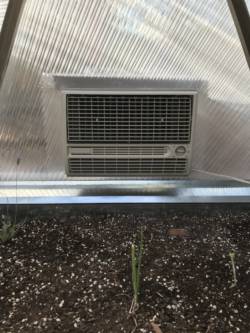
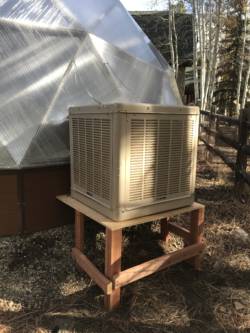
For solar-powered applications, we recommend Southwest Solar’s evaporative coolers. We have an 18″ swamp cooler in our 26′ dome, and we recently installed a 24″ in a customer’s 33′ Dome in Las Animas, CO. For 110V models, we recommend a window-mounted unit, like the one shown above. These have a smaller opening that will mount through the glazing similar to our fan units. We usually go with the manufacturer’s recommendation based on square footage. They get better efficiency if mounted towards the west for late-day cooling.
Unfortunately, if you live in humid climates, swamp coolers will increase humidity. Air conditioning units are the best option for humid climates. Too much moisture can cause a lot of problems, including mold.
Here Udgar explains the use of our solar powered swamp cooler. It is very effective for keeping the dome cool…up to 20° cooler while it is running. The swamp cooler blows air through a pad which is kept moist by water trickling down or being sucked up the pad.
The cooling pad is designed to let air flow through it.
The fan on this particular swamp cooler is driven by a solar panel. There’s a little pump which pumps water through the cooling pad on the outside and the air coming out is around 70°.
The second way we use the power of evaporating water is a Misting System.
Misting systems can be set on various types of timers or humidistat controllers. The light spray of water is effective at cooling the space, but use it judiciously to avoid too much moisture leading to mold or fungus. As simple as it sounds, our misting system included in the Desert Cooling Package connects easily to a garden hose or drip irrigation system. The full-surround misting system cools your greenhouse with evaporative cooling principles.
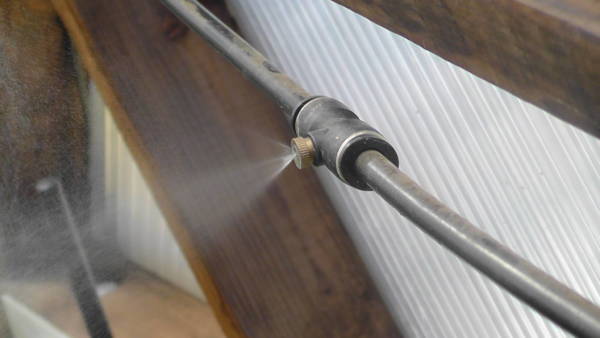
If you have a greenhouse, or a Growing Dome…
….you can bet it’s going to be hot in there too.
Learn how to keep an accurate track on the temperature. Don’t keep your thermometer in direct sunlight or propped up under a black pot!
Learn how to “listen” to your plants. They will tell you if it is too hot inside your greenhouse.
7 Methods on How to Cool a Greenhouse
- Plants and Transpiration
- Water Tank
- Solar and Electric Fans for Active Air Flow
- Automatic Vent Openers for Passive Air Flow
- Shade, inside and outside
- Undersoil Ventilation System
- Evaporative Coolers and Misting Systems
These are all cooling methods we have been able to keep our Growing Domes within an ideal temperature range – even in the middle of the hot summer.
Raised Bed Materials
If you are just building your new Growing Dome, and live in a warmer climate, it is important to use raised bed materials that do not retain heat. Pavestone and other retaining wall beds look absolutely amazing, but they can increase the temperature of your greenhouse in the summer. Building raised beds out of lumber will reduce the amount of heat stored in the raised bed materials.
Also, refer to our greenhouse planting schedule for a list of summer crops.
Please contact us if you’d like to get more information on Growing Domes. Or to receive more informative gardening and Growing Dome articles, please sign up for our monthly Newsletter “The Happy Grower”
